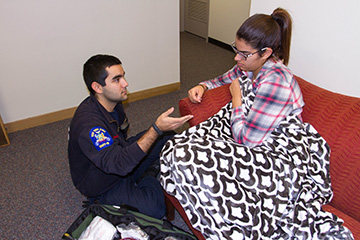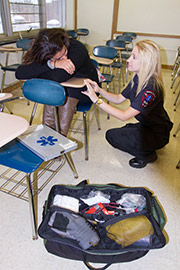First Responders to Sexual Assault Learn from College

05/03/2016
Many emergency first responders are well trained to handle to handle a variety of medical issues, but don’t know the right way to handle a sexual assault situation, according to SUNY Cortland associate professor Jena Nicols Curtis.
That’s not the case at SUNY Cortland, where research and training led by Curtis are setting an example for responders nationwide.
“All college campuses have too much sexual violence,” Curtis said. “What I’m most proud of with Cortland is that we are really committed to talking openly about and preventing sexual violence.”
 |
|
| Students in the SUNY Cortland Emergency Medical Services (SCEMS) role play their actions to help victims of sexual assault. Sydney Goldstein is shown in the photo above on the right helping a "victim," portrayed by Victoria Sobredo. In the image above left, John Ingardia assists a “survivor," a role played by Sobredo. |
To foster a ready response among emergency rescue professionals nationally, Curtis and her colleague, lecturer Susan Burnett M ’15, wrote an article for the April 2016 edition of the Journal of Emergency Medical Services (JEMS).
The piece, titled “The Role of EMS in Helping Survivors of Campus Sexual Violence,” outlines techniques that were validated earlier this year during the National Collegiate Emergency Medical Services Foundation’s annual conference in Philadelphia. There, the co-authors presented findings intended to benefit campus rescue personnel — such as the SUNY Cortland Emergency Medical Services (SCEMS) SUNY Cortland Emergency Medical Services (SCEMS) — and other organizations to a standing room-only audience.
The journal article was illustrated with photos of SUNY Cortland SCEMS responders demonstrating recommended techniques with Cortland students playing the roles of responders and victims.
Some of the approaches Curtis and Burnett suggest include:
- positioning themselves below the patient’s line of sight;
- learning how to deal with potential victim panic attacks;
- identifying intoxication; and,
- aiding someone who can’t stop crying.
“Often in a college atmosphere and in the public, we are not called on often enough for these situations,” Burnett said. “Someone needs to deal with not only a victim’s physical injuries, but their emotional ones as well.”
When she began her research on campus sexual assault five years ago, Curtis interviewed a diverse group of SUNY Cortland students to understand their interpretation of sexual assault.
“It became really obvious that people who experience sexual violence on campus didn’t recognize it was sexual violence,” Curtis said.
With that realization, Curtis, who serves as a graduate coordinator for the College’s Health Department, developed training for responders to address very individual situations.
Burnett, a senior paramedic for Rural Metro Medical Services of Central New York, has over the past 14 years been certified in many field positions. She works with several college campuses in the Syracuse region. When she was still a SUNY Cortland graduate student, Burnett assisted Curtis in designing a program that is useful not only at the College, but on other campuses.
As an advisory board member for SCEMS, Curtis began to implement the techniques with the College’s squad.
The squad receives around five to 10 calls for sexual assault a semester, according to SCEMS responder John Ingardia.
Student responders undergo a two-part training program to properly prepare for these situations. In the first half of the training, the responders develop their ability to identify what sexual violence looks like. In the second, they use role-play scenarios on how best to approach a victim.
“She (Curtis) has given us training that is a step above what you’ll typically get from an EMS provider,” said Ingardia, a senior community health major from Bellmore, N.Y. “I think her training should be mandated.”
“I love that the idea of this article is to train student EMTs to be more sensitive and aware of how these crimes could affect an individual to be reluctant to report,” said Nan Pasquarello, who as SUNY Cortland’s Title IX coordinator fulfills a federal mandate to mediate on behalf of sexual assault victims.
To further improve prevention and responses, Curtis and Burnett will continue researching sexual assault in a campus setting.
“Our students are volunteering their time and staying in the office late on weekends, but they need specific tools and skills to respond properly,” Curtis said of the College’s volunteer EMS responders. “They want to get this right.”
The College uses several sexual assault prevention initiatives, such as the national “It’s On Us” campaign to educate and encourage students to step in and intervene in situations in which they feel non-consensual sex seems likely to occur. Studies throughout the U.S. indicate that at least one in five women and one in 12 men experience unwanted sexual contact in college. To reinforce support for victims, stickers and resource cards are placed throughout campus with information to report on sexual violence.
For more information on reporting sexual assault at SUNY Cortland, visit cortland.edu/titleIX or contact Pasquarello at 607-753-4550.
To stay current with the College’s sexual assault prevention effort, “like” SUNY Cortland It’s On Us on Facebook, or “follow” on Twitter (@sc_itsonus) and Instagram (sunycortland.itsonus).
Prepared by public relations intern Bethany Lunden

